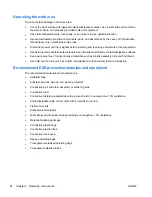
Preventing ESD equipment damage
Many electronic components are sensitive to ESD. Circuitry design and structure determine the degree
of sensitivity. The following packaging and grounding precautions are necessary to prevent damage to
electric components and accessories:
●
Transport products in static-safe containers such as tubes, bags, or boxes, to avoid hand contact.
●
Protect electrostatic parts and assemblies with nonconductive or approved containers or
packaging.
●
Keep electrostatic-sensitive parts in their containers until they arrive at static-free stations.
●
Place items on a grounded surface before removing them from containers.
●
When handling or touching a sensitive component or assembly, ground yourself by touching the
chassis.
●
Avoid contact with pins, leads, or circuitry.
●
Place reusable electrostatic-sensitive parts from assemblies in protective packaging or
nonconductive foam.
Personal grounding methods and equipment
Use the following items to help prevent ESD damage:
●
Wrist straps
—These are flexible straps with a maximum of one megohm ± 10% resistance in the
ground cords. To provide a proper ground, wear the strap against bare skin. The ground cord must
be connected and fit snugly into the banana plug connector on the grounding mat or workstation.
●
Heel straps, toe straps, and boot straps
—These can be used at standing workstations and are
compatible with most types of shoes or boots. On conductive floors or dissipative floor mats, use
them on both feet with a maximum of one megohm ± 10% resistance between the operator and
ground.
The following table shows protection levels available from static shielding materials.
Table 5-1
Static shielding protection levels
Method
Voltage
Antistatic plastic
Carbon-loaded plastic
Metallized laminate
1,500V
7,500V
15,000V
This section provides guidelines to prevent ESD damage to equipment.
ENWW
Service considerations
63
















































